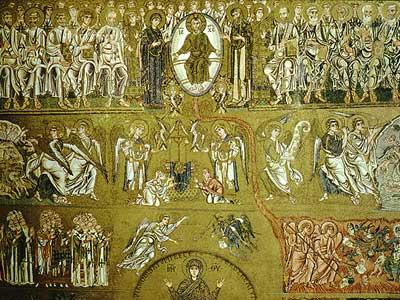- Goose
- Cogito ergo sum
 Offline
Offline 
- Registered: 1/29/2015
- Posts: 13,427
The Cathedral of Santa Maria Assunta
The Cathedral of Santa Maria Assunta (Cattedrale di Santa Maria Assunta) is a basilica church on the island of Torcello, Venice, northern Italy. It is a notable example of Venetian-Byzantine architecture, one of the most ancient religious edifices in the Veneto, and containing the earliest mosaics in the area of Venice.
According to an ancient inscription, it was founded by the exarch Isaac of Ravenna in 639, when Torcello was still a rival to the young nearby settlement at Venice.
The most important artistic element of the cathedral is the mosaics, the earliest remaining mosaics in the neighbourhood of Venice. The main apse has an 11th-century mosaic of famous beauty of the standing Virgin Hodegetria, isolated against a huge gold background, above a register of standing saints. These seem originally late 11th-century, by a team of Byzantine mosaicists, but the main figure was reworked a century later after an earthquake, while the saints remain from the first period of work. The west wall (over the door) was done in this second phase: from the top it contains a Crucifixion in the gable, then a vigorous Harrowing of Hell with a large figure of Christ, above a Last Judgement taking up four lower registers.
The skull of Saint Cecilia is also kept as a relic here.
Notice how images are used.
When one comes into the church for mass, you see the comforting image of the Virgin and Child
At the conclussion of Mass, one turns around to exit the church, and re-enter the world which is, of course, filled with sin.
Here, one is presented with images of the Last Judgment, with some truly horrific fates being handed out to the wicked.
A very strong reminder till next Sunday.
So, be good for goodess sake!



Last edited by Goose (10/08/2017 11:58 am)
We live in a time in which decent and otherwise sensible people are surrendering too easily to the hectoring of morons or extremists.
- tennyson
- Exchanger
 Offline
Offline 
- Registered: 2/06/2015
- Posts: 6,654
Re: The Cathedral of Santa Maria Assunta
Beautiful !
"Do not confuse motion and progress, A rocking horse keeps moving but does not make any progress"
- Goose
- Cogito ergo sum
 Offline
Offline 
- Registered: 1/29/2015
- Posts: 13,427
Re: The Cathedral of Santa Maria Assunta
I was really taken with the mosaics.
many of the churches in the region favor them over the frescos one would see in Tuscany or Rome.
It's the eastern influence at work.
Millions of tiny colored tiles, stones, and jewels making these stunning images.
Extremely cool!
We live in a time in which decent and otherwise sensible people are surrendering too easily to the hectoring of morons or extremists.
- •
- Tarnation
- Administrator
 Offline
Offline - From: Upstream where water's clean
- Registered: 1/29/2015
- Posts: 1,241
Re: The Cathedral of Santa Maria Assunta
The mosaics in the apse appear to be inspired by Byzantine Iconography.
The Theotokos is the "Directress", believed to been written for the first time by Luke the Evangelist. "Directress" is because she points to her Holy Son. The lower tier of saints resemble those found surrounding the Altar even in 20th century Orthodox Churches.
A fine reminder that for over 1000 years there was but "one holy, catholic, and apostolic Church".
Life is an Orthros.
- Goose
- Cogito ergo sum
 Offline
Offline 
- Registered: 1/29/2015
- Posts: 13,427
Re: The Cathedral of Santa Maria Assunta
Indeed, in 540 during the Gothic War, Ravenna was occupied by the Byzantine general Belisarius. And Torcello, where this church is located, was part of the Exarchate of Ravenna or of Italy and was a center of Byzantine power in Italy, from 584 to 751 when it was lost to the Lombards.
Torcello benefited from and maintained close cultural and trading ties with Constantinople.
Theotokos (Virgin Mary) holding the Child Jesus at her side while pointing to Him as the source of salvation for humankind. In the Western Church this type of icon is sometimes called Our Lady of the Way.
It is thought to be the work of a team of Byzantine mosaicists.
We live in a time in which decent and otherwise sensible people are surrendering too easily to the hectoring of morons or extremists.
- •
 1 of 1
1 of 1
